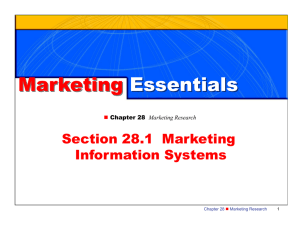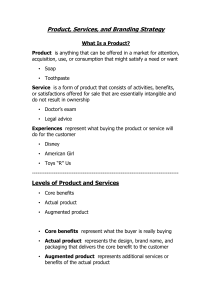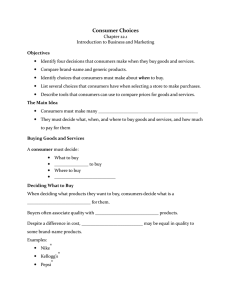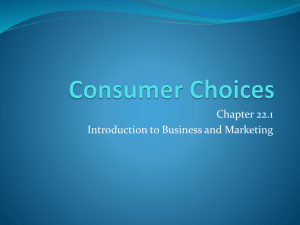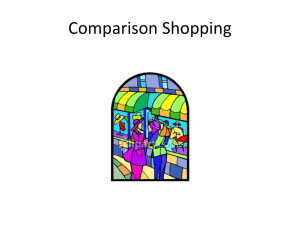1.2.1 Buying Goods and Services
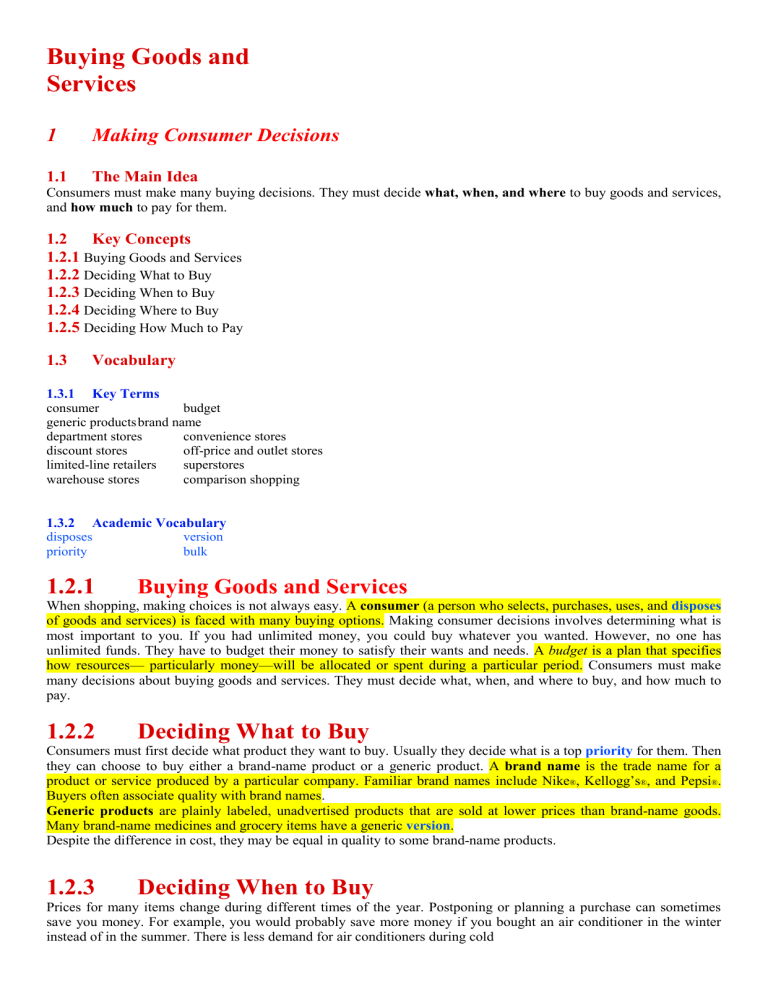
Buying Goods and
Services
1 Making Consumer Decisions
1.1 The Main Idea
Consumers must make many buying decisions. They must decide what, when, and where to buy goods and services, and how much to pay for them.
1.2 Key Concepts
1.2.1
Buying Goods and Services
1.2.2
Deciding What to Buy
1.2.3
Deciding When to Buy
1.2.4
Deciding Where to Buy
1.2.5
Deciding How Much to Pay
1.3 Vocabulary
1.3.1 Key Terms consumer department stores budget generic products brand name convenience stores discount stores off-price and outlet stores limited-line retailers superstores warehouse stores comparison shopping
1.3.2 Academic Vocabulary disposes priority version bulk
1.2.1
Buying Goods and Services
When shopping, making choices is not always easy. A consumer (a person who selects, purchases, uses, and disposes of goods and services) is faced with many buying options. Making consumer decisions involves determining what is most important to you. If you had unlimited money, you could buy whatever you wanted. However, no one has unlimited funds. They have to budget their money to satisfy their wants and needs. A budget is a plan that specifies how resources— particularly money—will be allocated or spent during a particular period. Consumers must make many decisions about buying goods and services. They must decide what, when, and where to buy, and how much to pay.
1.2.2 Deciding What to Buy
Consumers must first decide what product they want to buy. Usually they decide what is a top priority for them. Then they can choose to buy either a brand-name product or a generic product. A brand name is the trade name for a product or service produced by a particular company. Familiar brand names include Nike
®
, Kellogg’s
®
, and Pepsi
®
.
Buyers often associate quality with brand names.
Generic products are plainly labeled, unadvertised products that are sold at lower prices than brand-name goods.
Many brand-name medicines and grocery items have a generic version .
Despite the difference in cost, they may be equal in quality to some brand-name products.
1.2.3 Deciding When to Buy
Prices for many items change during different times of the year. Postponing or planning a purchase can sometimes save you money. For example, you would probably save more money if you bought an air conditioner in the winter instead of in the summer. There is less demand for air conditioners during cold
months, which means prices for them are lower then. Stores often run special promotions during and after holidays, just before a school year begins, and at the end of a season. There are often more choices when products are first available. However, you may find better prices if you wait until the items go on sale.
1.2.4 Deciding Where to Buy
Along with choosing what to buy, consumers have to decide where to shop. There are three factors that affect a consumer’s decision on where to shop: the kinds of goods and services sold, prices, and convenience.
Department Stores
Department stores sell a wide variety of goods. Because they offer name brands and customer service, their prices may be higher than other types of stores. Most sell many lines of products, such as furniture, clothing, and shoes. They include Sears, JCPenney ®
, and Macy’s
® .
Discount Stores
Discount stores also sell a variety of goods. However, discount stores generally offer lower prices. They can sell for less because they offer fewer services and keep large quantities of goods. They include Wal-Mart
® and Kmart
®
.
Off-Price and Outlet Stores
These types of stores carry well-known brand names at bargain prices. They offer big discounts because the items they sell may have flaws, may be out of season, or may be discontinued merchandise. Examples are T.J. Maxx ® , Stein
Mart ® , and Loehmann’s ® .
Limited-Line Retailers
Limited-line retailers, or specialty stores, sell an assortment of goods in one product line or a few related lines. They often have a variety of items and high levels of service and expertise. Foot Locker
®
, PetSmart
®
, and Ace Hardware
® are specialty stores.
Superstores
Superstores are like supermarkets but sell items such as books, hardware, sporting goods, and clothing as well as groceries. Like supermarkets, they are also self-serve. Kroger ® , Wal-Mart, and Safeway ® operate superstores.
Convenience Stores
As their name implies, convenience stores provide easy access to products that consumers often buy as necessities or impulse items. They offer limited lines of products, mostly grocery items. The world’s largest chain of convenience stores is run by 7-Eleven
®
.
Warehouse Stores
Warehouse stores are typically about the size of a football field. They carry a huge selection of food and nonfood items at low prices and in bulk quantities. Some require customers to become members to get buying privileges and discounts. They include Costco and Sam’s Club.
Shopping at Home
Consumers can shop at home through TV channels, catalogs, or the Internet. Some companies such as Service
Merchandise sell items only on the Internet. Others offer catalog and online services. Some retail stores, such as Crate
& Barrel and Eddie Bauer, also mail catalogs.
1.2.5
Deciding How Much to Pay
Comparison shopping is an important factor in buying products or services. Comparison shopping is comparing the prices and the characteristics of competing brands or stores. It is most important for major purchases because the difference in cost can be signifi cant. Some people think the most expensive item is always the best product. However, sometimes the least expensive item or the one in the middle might be the best buy for the money.
2 How to Be a Smart Consumer
2.1 The Main Idea
To get the most value for your money, you can collect information to make an informed decision when you shop. You should plan ahead so that you can make the best choices and get the best buys.
2.2 Key Concept
2.2.1
Preparing to Shop
2.3 Vocabulary
2.3.1 Key Terms rational advertising emotional advertising promotional sale clearance sale consumer magazines loss leaders impulse buying warranty
2.3.2 Academic Vocabulary convince publications label document
2.2.1 Preparing to Shop
Consumers have to decide what a bargain is to them. You can become a smart consumer by planning in advance.
Before making a purchase, a smart consumer should
• study advertisements.
• read consumer publications.
• shop at sales.
• use shopping lists.
• resist pressure and gimmicks.
• read labels and warranties.
Study Advertisements
To be a wise consumer, you must learn how to read ads for information that will be helpful. Most ads are one of two types.
Rational advertising attempts to convince consumers with facts and information. It tries to persuade buyers to choose a specific product because it is the best one for their purposes.
Emotional advertising appeals to people’s feelings. For example, it might suggest that if consumers buy a particular car, they will be popular.
When you look at advertising, decide whether it provides useful information. An ad that simply says, “The best buy in town!” will not necessarily help you become a smarter consumer. However, an ad that says, “6 oz. Sparkle-Plenty
Toothpaste, $1.99,” might be very helpful. If you know that this toothpaste is good and usually sells for $2.79 for 6 ounces, then you will know that the sale is a good buy.
Read Consumer Publications
Publications such as Consumer Reports and
Consumers’ Research Magazine give detailed information about goods that have been tested and rated. If you need to buy an expensive item, you can begin comparison shopping by studying what these magazines say about the competing brands.
Consumer magazines examine and rate products ranging from bottled iced teas to travel agencies. Many specialty magazines, such as those for photographers or hikers, rate equipment such as cameras or hiking boots. Libraries and online services are good places to find these publications .
Shop at Sales
Stores often use sales to attract customers. A promotional sale is one that offers a special buy on a new product or a product that is in season. It is usually held at a time when consumer purchases are down, such as after holidays.
A clearance sale is a sale to clear out goods that are going out of season or are no longer profitable. These sales often make room for new merchandise. Clearance sales often mark the end of a season.
Many businesses also hold other sales throughout the year. During a sale, look for products that are advertised as selling at a loss or below cost.
Loss leaders are advertised products that sell at a loss to bring customers into a store. Even though a store does not make money on them, their low prices are intended to attract more customers. Store managers hope consumers will buy other items along with loss leaders.
Use Shopping Lists
Impulse buying is the act of making unplanned purchases. Impulse buying can ruin a consumer’s budget and result in buying items that are not needed. To cut down on unplanned buying, use a shopping list. It might keep you from making unnecessary shopping trips because you forgot something you need. It can also save you money, because you can decide in advance what to buy and how much to spend.
Resist Pressure and Gimmicks
Some salespeople use high-pressure tactics to get consumers to buy their goods and services. They can be very persuasive. You should always ask yourself if what the salesperson is saying is true, if you need the product or service, and if you can afford it. Sales gimmicks , such as ads for prizes or “super-low prices,” are meant to grab consumers’ attention and get them into a store to buy something. For example, you might get a notice in the mail that says you have won a prize. However, after reading closely, you realize you will not get the prize unless you buy something.
Always examine any deal that seems too good to be true.
Read Labels and Warranties
Before buying a product, read its label . You might find information on it that will lead you to decide not to buy the product. For instance, before buying fruit juice, read the food label for the contents. What you thought was 100 percent fruit juice could mainly be corn syrup and water.
Many items come with a warranty. A warranty is a written guarantee from the manufacturer or distributor that states the conditions under which the product can be returned, replaced, or repaired. It is a legal document that states the rights and responsibilities of the consumer and the store or manufacturer.
Federal law requires sellers of products that cost more than $15 (and that have a warranty) to make the warranty available to customers before a purchase. It is often printed on the package.
Warranties are divided into two basic types: implied and express .
Implied warranties are unwritten guarantees that cover certain aspects of a product or its use. An implied warranty of mechantability guarantees that a product is fit for its intended use.
Express warranties, which are usually written, come in two forms.
Full warranties state that the seller will repair or replace a product that does not work, usually free of charge, or give a refund. Full warranties are usually good for a stated time period, such as 90 days or one year.
Limited warranties cover only certain parts of a product. They may require the buyer to pay a portion of the repair costs.
Buying Goods and Services:
Consumer Choices
Making shopping decisions is not always easy, especially when there are many options available. Most people have limited funds. As consumers, they have to budget their money to satisfy their wants and needs. Consumers
must decide what, when, and where to buy goods and services as well as how much to pay for them. They must also decide whether to buy generic or brand-name items. The best buy depends on what is important to the individual consumer.
How to Be a Smart Consumer
You can become a smart consumer by planning in advance. Smart consumers study advertisements, read consumer publications, and shop at sales. They also use shopping lists, resist pressure and gimmicks to buy goods and services, and read labels and warranties. Many consumers turn to consumer magazines when researching products and services.
Planning helps them to avoid impulse buying and allows consumers to get the best warranty.
Key Terms consumer department stores budget generic products brand name convenience stores discount stores off-price and outlet stores limited-line retailers superstores warehouse stores rational advertising comparison shopping emotional advertising promotional sale clearance sale consumer magazines loss leaders impulse buying warranty (implied, express, limited, full)
Academic Vocabulary disposes priority version bulk convince publications label document ultimate
